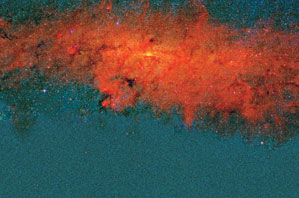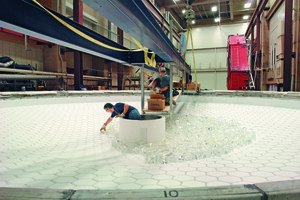
CALTECH/LSSOur galaxy: the red represents radiation from stars (bright spots) and clouds of gas and dust . The yellowish area indicates the center of the Milky Way, with a massive black holeCALTECH/LSS
From Rio de Janeiro
The Brazilian astronomers who met in late May at the Observatório Nacional observatory (ON) with representatives from the world’s 15 biggest telescopes currently under construction – some of which are huge, equipped with reflector mirrors three or four times bigger than the ones found in existing telescopes – are worried about becoming isolated from what is happening around the world. They fear that they will have to continue working with equipment that will soon be comparable to ancient Volkswagen beetles, while their colleagues from abroad drive Ferraris.
“There will be a great leap forward abroad”, says Paulo Pellegrini, an astrophysicist at the ON. “If you’re not organized and prepared, you’re going to lag behind.” In addition to more powerful telescopes, which are expected to govern discoveries in the next decades, new objects, such as planets outside the solar system, will emerge as targets for studies, especially planets that might show some possibility of life. In mid-June, a group of European astronomers introduced three new rocky planets outside the solar system, whose masses were relatively close to that of the Earth. These planets orbit around a single star; nearly all of the 303 such planets that have already been identified were gaseous, much bigger, much hotter, and uninhabitable. “Fifteen years ago, nobody talked about planets outside the solar system or about dark energy”, recalled Verne Smith, from the United States’ National Optical Astronomy Observatory (NOAO), during the three-day meeting at the Observatório Nacional.
The week before, astrophysicists from five federal research institutes linked to the Ministry of Science and Technology/MST had concluded a 50-page analysis of the limits and possibilities of astronomy-related actions in Brazil. The next version is expected to add to the conclusion of the meeting held in May in Rio and, later on, the comments of as many as possible of the nearly 500 professional astronomers in Brazil. “Whatever we decide now”, says Pellegrini, “will define the future of Brazilian astronomy.” The final version, together with an action plan, is expected to be presented this year. The action plan will provide a framework for the agencies that provide the funding for scientific research in Brazil. “It would be easier to make decisions on which research projects should be supported if we had a united research program”, says Avílio Franco, who supervises the technological and research institutes department at Finep, Brazil’s projects and studies finance agency. “Brazil cannot afford to support only three or four research groups in such a specific field.”
Researchers from the states of Rio de Janeiro, São Paulo, Rio Grande do Sul and Rio Grande do Norte talked a lot at the ON about what to do. “We don’t need huge telescopes”, says Luiz Nicolaci da Costa, an astrophysicist from the ON and coordinator of the meeting. Given the difficulty of developing high tech equipment as the country’s counterpart in international projects, he proposes that: “We can work on data processing.”
There will be a great amount of data. The Large Synoptic Survey Telescope (LSST) alone, expected to go into operation in 2015 with an 8.4-meter mirror, is expected to produce a 7-gigabyte image of the skies, which is equivalent to 1.5 DVDs every 20 seconds. “We have to be ready when the data from the huge telescopes starts to arrive”, says Márcio Maia, from the ON. The Brazilian astronomers have already taken part in the data analysis of two international projects. One is the Sloan Digital Sky Survey-III, the goal of which is to map 1 billion galaxies. The other is the Dark Energy Survey, focused on dark energy. Even physicists are not sure what this is. The question is what to do and where to go after 2017, when the Dark Energy Survey project is concluded.
Nicolaci, who heads this group that does not want to remain in the shadows, knows that it will not be easy to prioritize projects, establish a common plan, overcome rivalries among research groups and find a balance between scientific, technological and social costs and benefits. “The analyses on work alternatives have to be done together, by means of dialogue”, says Nicolaci, who worked for 16 years in the United States, France and Germany on international astronomy projects before coming back to Brazil in 2005. Franco says that “the groups have to be connected and work together, especially in projects that entail higher values”.

TMT
TMT, one of the biggest telescopes under construction: 30-meter mirrorTMTThe future might also bring new ways of working. A possibility being considered is to bring astrophysicists, particle physicists and theoretical physicists together, using the results of observations of the skies and understanding the evolution of the Universe. “We can create a common language”, says Maia. “Theoretical physicists have already realized that it is not enough to have good theory; it is also necessary to have solid proof of the theory”. Charles Steidel, from the California Technology Institute /Caltech, suggests that: “We should think about fields of discovery, rather than about specific issues.”
The new telescopes under construction might provide new discoveries and also computer programs and image treatment techniques. In addition, they can be useful for medicine or biology. Similar thinking might also arise in other fields. Franco, who coordinated the federal research institutes under the Ministry of Science and Technology prior to joining Finep, emphasizes: “We need to move forward in terms of a joint research program for Brazil.”
At a congress on the social study of science and technology, held at the same time as the physicists’ meeting, Pablo Kreimer, a professor at the National University of Quilmes, Argentina, showed that a broad range of scientific activities – as astronomy, in this case – expressed the drama of how to produce and use knowledge. In the article Dependientes o integrados? – La ciencia latinoamericana y la nueva división internacional del trabajo [Dependent or integrated? Latin-American science and the new international division of labor], published in the journal Nómadas, Kreimer suggests that one way of solving this stalemate is to acknowledge the tension found between subordination and autonomy and to explore the space for negotiation.
In his article, Kreimer takes up the concept he created with another professor from Quilmes, Hernán Thomas, which is the notion of non-applied applicable knowledge. His article states that “The research groups that are more integrated in mega research networks generally produce a lot and their production has prestige, but their support of the development of local societies has been historically marginal.” In his opinion, the current model of scientific production has resulted in more symbolic rather than material consequences, because this model has basically increased the visibility of the researchers rather than generating locally useful knowledge.
At the opening address of this congress, Michel Callon, a professor of sociology at the Paris School of Mines, talked about the original trajectories he encountered when he applied the theories of the sociology of science to the field of economics; the said theories preach that science and the society that produces it should not be viewed separately. In Norway, fishermen created quota rights whereby they could only catch a pre-established quantity of fish. “A community can be ruined if resources are not shared”, he pointed out. Callon explained that each fisherman would catch as much as he could until the fish became extinct if he was not entitled to this right of property. This right was based on studies that established the quantity of fish, how the fish lived and where the fish to be divided were found. “The right of property transformed the dark ocean into a transparent aquarium”, said Callon. “The fishermen, who had never worried about the economy, turned into Homo economicus and began to sell the fishing rights.”
A similar approach governs the construction and use of the big telescopes, given that that each country or institution becomes a partner in the venture and purchases participation quotas that are later converted into proportional hours during which the participants can use the equipment. This is how Brazilian astronomers currently have access to three telescopes built by international consortiums and still considered large: two of them, with 8-meter mirrors, are part of the Gemini Project in Hawaii and in Chile; the other, with a 4.1-meter mirror, is part of Soar, also in Chile. The right to use the equipment, defined through quotas, might become unfeasible in view of the remote possibility that Brazil would have to disburse millions of dollars quickly to participate in the construction of even bigger telescopes.
The Thirty Meter Telescope (TMT), one of the biggest under construction, has a mirror whose diameter measures 30 meters, nearly four times that of the biggest current telescopes. The TMT is scheduled to go into operation in 2016 at an estimated cost of US$ 754 million. As the governments of the United States, Canada and Japan were unable to cover the total costs, the Gordon & Betty Moore Foundation will donate US$ 50 million, strengthening the trend of partnerships between public and private institutions in this kind of venture. “We are anxiously hoping for other partnerships”, says Wendy Freeman, director of California’s Carnegie Observatory, which houses the Giant Magellan Telescope (GMT), whose mirror measures 25 meters, or the length of six Gol cars parked in line.
Republish